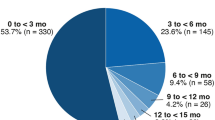Abstract
Background
Retinal vein occlusion (RVO) is the second leading cause of vascular eye disease. Currently there is no definite treatment for this condition. Animal models could be potentially helpful in developing new treatments; however, it is essential to understand the differences these models may have with human RVO. The aim of our study was to examine the course of experimentally created retinal vein occlusion (RVO) in rabbits.
Methods
Twenty-nine pigmented rabbits were included in the study. RVO was created in all using an argon green laser following intravenous injection of Rose Bengal. A laser was applied to all major veins at the optic disc margin to mimic central retinal vein occlusion. Animals were followed-up for a maximum of 2 months.
Results
Immediately following laser application, blood flow ceased or the flow was extremely slow in the retinal veins in all cases. At day 2 post laser, 86% showed significant retinal hemorrhages. On FA, no retinal blood flow was observed in the eye (neither arteries nor veins) in the majority of rabbits. Between weeks 1 and 3, laser sites reopened and partial or complete revascularization of both retinal arteries and veins occurred; however, the vascular pattern was abnormal.
Conclusions
RVO in rabbits has a different course than in human and it can be classified into three stages. At stage 1 (the first few days after laser photothrombosis), there is a retrograde propagation of the blood clot in the retinal veins that extends to the retinal arteries and choriocapillaries. As a result, there is no retinal blood flow at this stage in most cases. At stage 2 (between weeks 1 and 3), partial or complete revascularization occurs but the vessels have an abnormal pattern. At stage 3 (after week 3) no significant change takes place.









Similar content being viewed by others
References
Klein R et al (2000) The epidemiology of retinal vein occlusion: the Beaver Dam Eye Study. Trans Am Ophthalmol Soc 98:133–141, discussion 141–3
Nanda SK et al (1987) A new method for vascular occlusion. Photochemical initiation of thrombosis. Arch Ophthalmol 105(8):1121–1124
Royster AJ et al (1988) Photochemical initiation of thrombosis. Fluorescein angiographic, histologic, and ultrastructural alterations in the choroid, retinal pigment epithelium, and retina. Arch Ophthalmol 106(11):1608–1614
Oncel M, Peyman GA, Khoobehi B (1989) Tissue plasminogen activator in the treatment of experimental retinal vein occlusion. Retina 9(1):1–7
Kliman GH et al (1994) Retinal and choroidal vessel closure using phthalocyanine photodynamic therapy. Lasers Surg Med 15(1):11–18, doi:10.1002/lsm.1900150104
Iliaki OE et al (1996) Photothrombosis of retinal and choroidal vessels in rabbit eyes using chloroaluminum sulfonated phthalocyanine and a diode laser. Lasers Surg Med 19(3):311–323 doi:10.1002/(SICI)1096–9101
Larsson J, Carlson J, Olsson SB (1998) Ultrasound enhanced thrombolysis in experimental retinal vein occlusion in the rabbit. Br J Ophthalmol 82(12):1438–1440
Arroyo JG, Dastgheib K, Hatchell DL (2001) Antithrombotic effect of ticlopidine in an experimental model of retinal vein occlusion. Jpn J Ophthalmol 45(4):359–362, doi:10.1016/S0021–5155(01)00337–9
Wang H, Shen Z (2001) Experimental research of laser-induced collaterals in retinal vein occlusion. Zhonghua Yan Ke Za Zhi 37(4):298–301
Ma J et al (2005) Experimental study on relationship between retinal vein occlusion and loss of vitreous gel mass. Mol Vis 11:744–748
Linner E (1961) Occlusion of the retinal veins in rabbits induced by light coagulation. Acta Ophthalmol (Copenh) 39:739–740
Voipio H, Raitta C (1964) Branch vein occlusion by photocoagulation in the rabbit eye. Acta Ophthalmol (Copenh) 42:544–549
Mutlu F (1966) Experimental retinal vein occlusion and treatment with fibrinolysin. Am J Ophthalmol 62(2):282–286
Sakuraba T (1989) Experimental retinal vein obstruction induced by transadventitial administration of thrombin in the rabbit. Nippon Ganka Gakkai Zasshi 93(10):978–985
Matsumoto M (1992) Experimental study on earlier thrombogenic process in thrombin induced retinal venous obstruction in rabbit eye. Nippon Ganka Gakkai Zasshi 96(9):1132–1141
Suzuki Y et al (1996) Medical treatment for experimental retinal vein occlusion–thrombolytic effect of nasaruplase. Nippon Ganka Gakkai Zasshi 100(1):27–33
Katoh C (1998) Measurement of retinal blood flow velocity by scanning laser ophthalmoscopic fluorescein fundus angiography in experimental retinal vein obstruction. Nippon Ganka Gakkai Zasshi 102(5):307–311
Tamura M (2001) Neovascularization in experimental retinal venous obstruction in rabbits. Jpn J Ophthalmol 45(2):144–150, doi:10.1016/S0021–5155(00)00353–1
Ameri H et al (2008) Intravitreal and subretinal injection of tissue plasminogen activator (tpa) in the treatment of experimentally created retinal vein occlusion in rabbits. Retina 28(2):350–355
Ruskell G (1964) Blood vessels of the orbit and globe. In: Prince J (ed) The rabbit in eye research. Charles C., Thomas: Springfield, IL. pp 514–553
Sugiyama K et al (1992) Optic nerve head microvasculature of the rabbit eye. Invest Ophthalmol Vis Sci 33(7):2251–2261
Yamashita A et al (2006) Factor XI contributes to thrombus propagation on injured neointima of the rabbit iliac artery. J Thromb Haemost 4(7):1496–1501, doi:10.1111/j.1538–7836.2006.01973.x
Cam Y et al (2006) Evaluation of some coagulation parameters in hepatic coccidiosis experimentally induced with Eimeria stiedai in rabbits. J Vet Med B Infect Dis Vet Public Health 53(4):201–202, doi:10.1111/j.1439–0450.2006.00938.x
Wong PC et al (2007) Razaxaban, a direct factor Xa inhibitor, in combination with aspirin and/or clopidogrel improves low-dose antithrombotic activity without enhancing bleeding liability in rabbits. J Thromb Thrombolysis 24(1):43–51
Acknowledgements
This study was supported by the W.M. Keck Foundation and a private grant from Mr. Louis Fox. The authors would like to thank Lina Flores, Fernando Gallardo and Xiaopeng Wang, PhD, for their technical support.
Author information
Authors and Affiliations
Corresponding author
Rights and permissions
About this article
Cite this article
Ameri, H., Ratanapakorn, T., Rao, N.A. et al. Natural course of experimental retinal vein occlusion in rabbit; arterial occlusion following venous photothrombosis. Graefes Arch Clin Exp Ophthalmol 246, 1429–1439 (2008). https://doi.org/10.1007/s00417-008-0878-4
Received:
Revised:
Accepted:
Published:
Issue Date:
DOI: https://doi.org/10.1007/s00417-008-0878-4




